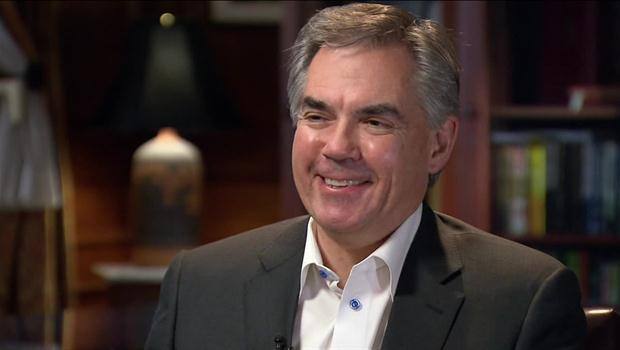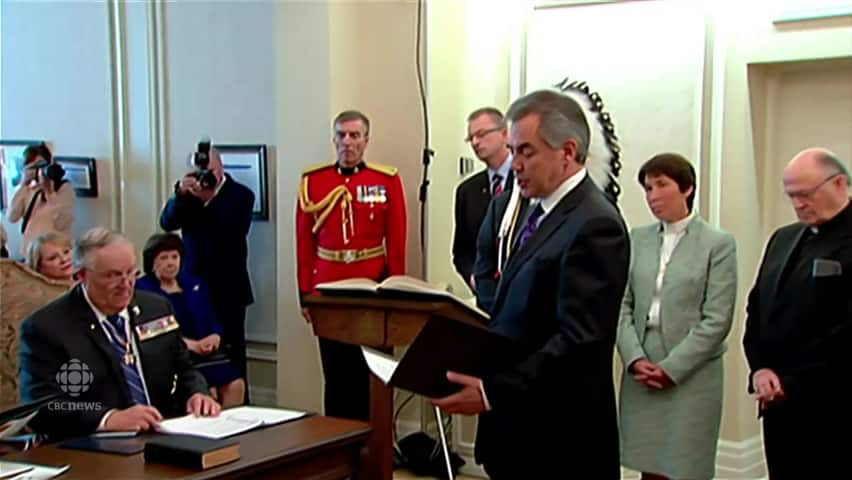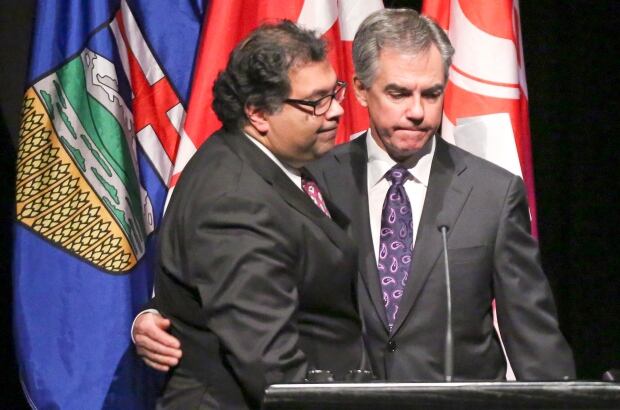Twin-engine Cessna en route to Calgary area disappeared from radar shortly after leaving Kelowna on Thursday
By Robson Fletcher, CBC News Posted: Oct 14, 2016 10:49 AM MTLast Updated: Oct 14, 2016 6:05 PM MT

Related Stories
- ‘He deeply loved Alberta’: Premier Rachel Notley on death of Jim Prentice
- Plane crashes near Kelowna, B.C., leaving 4 dead
- Friends, colleagues devastated after death of ‘devoted public servant’ Jim Prentice
- Jim Prentice: From gold miner’s son to Alberta premier
- Jim Prentice remembered by Edmonton and northern Alberta Tories
Former Alberta premier Jim Prentice was among the four people killed in a small-plane crash in British Columbia on Thursday night.
Prentice, 60, was aboard a twin-engine Cessna Citation that disappeared from radar shortly after takeoff from Kelowna, en route to the Springbank Airport, just outside Calgary.
- Small plane crashes near Kelowna, B.C., leaving 4 dead
- Colleagues, friends mourn the death of former Alberta premier Jim Prentice
Bill Yearwood with the Transportation Safety Board confirmed Friday that the plane’s wreckage was found in Lake Country, B.C., just north of Kelowna, and described the crash as “unsurvivable.”
“The aircraft is destroyed; all persons on board lost their lives,” Yearwood said.

Aerial footage of B.C. plane crash
Also killed in the crash was Ken Gellatly, the father-in-law of Prentice’s daughter Cassia.
The Prentice family issued a statement Friday, saying the loss of two family members at once is “unbelievably painful.”
“Words cannot begin to express our profound shock and heartbreak,” the statement reads.
The plane is owned by Calgary-based Norjet Inc. The company stated it will co-operate with the Transportation Safety Board’s investigation.
“Norjet lost friends in the tragic crash near Kelowna and we are struggling to cope with that loss,” according to the press release.
Prentice became Alberta premier in September 2014 when he won the leadership of Progressive Conservative Party.
In February 2015, Prentice discussed the challenges facing his province and the country at large in the wake of plunging oil prices in an extended interview with Peter Mansbridge.

Mansbridge One on One: Jim Prentice
In May 2015, the PCs were handed their first electoral defeat in nearly half a century, at the hands of the Alberta NDP, and Prentice resigned as both party leader and member of the legislature.
Before becoming premier, he served as vice-chair and senior executive vice-president with CIBC from 2010 to 2014.
Prentice also had a career in federal politics. He served as MP for Calgary Centre-North from 2004 to 2010, with stints as industry minister, environment minister and minister of Indian affairs and northern development in Stephen Harper’s cabinet.
‘He really cared deeply about the people he served, and he was always devoted to their best interests.’ – Joe Oliver, former Conservative finance minister
Alberta Premier Rachel Notley was among those offering their condolences Friday.
“There are no words adequate for moments like this, as my family knows very well,” said Notley, whose own father died in a plane crash on Oct. 19, 1984.
“[Prentice] worked tirelessly for all of us, in the true spirit of one who is committed to public service. I benefited from his advice, and the government of Alberta is continuing to pursue many of his initiatives. All Albertans are the better for this,” she said in a statement.
Former Alberta premier Alison Redford described Prentice as an “icon” — a thoughtful man who looked to the long term and successfully brought people together to deal with difficult issues.
As a young lawyer, Redford articled for Prentice. Both shared an interest in politics.

A timeline of Jim Prentice’s leadership in Alberta politics
“The work that we were doing at the time was around the development of the Oldman River Dam in southern Alberta,” she said. “I had the opportunity to spend a lot of time with him in southern Alberta meeting ranchers and meeting First Nations leaders. That connection to land and environment was something that was always important to him, and something I think touched everything he did in his life.”
Former Conservative finance minister Joe Oliver described Prentice as a passionate and skilled public servant who got into politics for all the right reasons.
“He really cared deeply about the people he served, and he was always devoted to their best interests,” Oliver said.
“He was never pompous. He was always a straight shooter, someone whose integrity and good judgment you could always rely on.”
Calgary Mayor Naheed Nenshi expressed a similar sentiment.
“In politics, I get to work with people from all political stripes who are filled with a desire to do good no matter what. I also get to work with people who are thoughtful, respectful and driven by a need improve this community we all share,” he said.
“Jim was all of these things, and so much more. He is an inspiration to all of us who aspire to public service.”

Calgary Mayor Naheed Nenshi and former Alberta premier Jim Prentice embrace during a memorial service for Alberta member of the legislature Manmeet Bhullar, who was killed in a car crash in November 2015. On Friday, Nenshi reacted to the death of Prentice by saying: ‘He is an inspiration to all of us who aspire to public service.’ (Mike Ridewood/Canadian Press)
Nenshi recalled Prentice’s connection with Alberta member of the legislature Manmeet Bhullar, who was killed in a car crash in November 2015.
“When the Sikh community was struggling to set itself up in Calgary and trying to build the first gurdwara in this city, they faced a lot of opposition from a community that didn’t know much about their faith,” Nenshi said.
“They were represented by an idealistic young lawyer who fought for respect, acceptance and diversity. That lawyer was named Jim Prentice.”
‘Strong voice for the people,’ PM says
Prime Minister Justin Trudeau described Prentice as a skilled politician and said he will “profoundly” miss him, despite their political differences in the past.
“Jim was a man who brought his deep convictions to everything he turned his hand to, whether it was law, business or politics,” Trudeau said.
“At each step of his career, Jim was a strong voice for the people of Alberta and for the people of Canada. He was highly respected and well-liked in the House of Commons across all party lines, because he brought an intelligent, honest and straightforward approach to everything he did.”
Interim Conservative Leader Rona Ambrose praised Prentice for his devotion to the party and public service and said he had much to be proud of in his political career, although that was just one aspect of his life.
“He was most proud of being a good husband, a good father and a very proud new grandfather,” she said.
Passion for politics
This June, Prentice became an energy adviser with Warburg Pincus, an international private equity firm, but politics was always a passion of his.
He started working for federal and provincial parties at age 20, mostly in backrooms, before stepping into the spotlight himself later in life.
Apart from one failed run for provincial office in 1986, he said he had an agreement with his wife, Karen, to wait until their three children were grown before venturing into the rigours of elected life.
But long before he would hold political office, Prentice was a boy who grew up “under the bins” of a coal mine.
Prentice, as a university student, worked seven summers underground in choking dust and heat amid deafening machinery.
Ontario roots
Prentice was born on July 20, 1956, in South Porcupine in northern Ontario.

Robin Campbell talks about losing friend Jim Prentice
His dad, Eric Prentice, was a gold miner and former pro hockey player, a 17-year-old whiz-kid winger and the youngest player ever signed by the Toronto Maple Leafs. He was a career minor leaguer, but had a minor stint in the big leagues — playing five games with Toronto in 1943.
As the gold mine dwindled, Eric Prentice picked up his family in 1969 and moved to a new coal mine in Grande Cache, Alta., when Jim was 13, and eventually to the mines farther south in the Crowsnest Pass.
Jim Prentice became a top-flight winger in his own right, but his promising junior hockey career ended with a devastating knee-on-knee hit.
From then on, he focused on university, graduating with a law degree before working in Alberta as an entrepreneur and a lawyer dealing mainly with land and property rights.
Conservative reunification
After his failed 1986 bid for provincial office, Prentice wouldn’t take a political run again until 2002, when he earned the PC nomination in Calgary Southwest, but later withdrew as a byelection candidate.
The federal conservative movement was in turmoil at the time, fractured between the PCs and the Canadian Alliance.
Prentice urged reunification and stepped aside so that Alliance leader Stephen Harper could run unopposed to represent the centre-right.
In 2004, at age 47, he won the Calgary riding for the newly merged Conservative Party.
In 2006, Harper won a minority government and Prentice was in cabinet. Over the following six-plus years, he was given high marks for his work in diverse portfolios — in the ministries of Indian and northern affairs, industry, and environment.
But the defining moment, he said, came before his cabinet days, when the Conservatives were still the Opposition in 2005.
Prentice decided to vote for a controversial Liberal bill endorsing same-sex marriage.
With files from The Canadian Press



